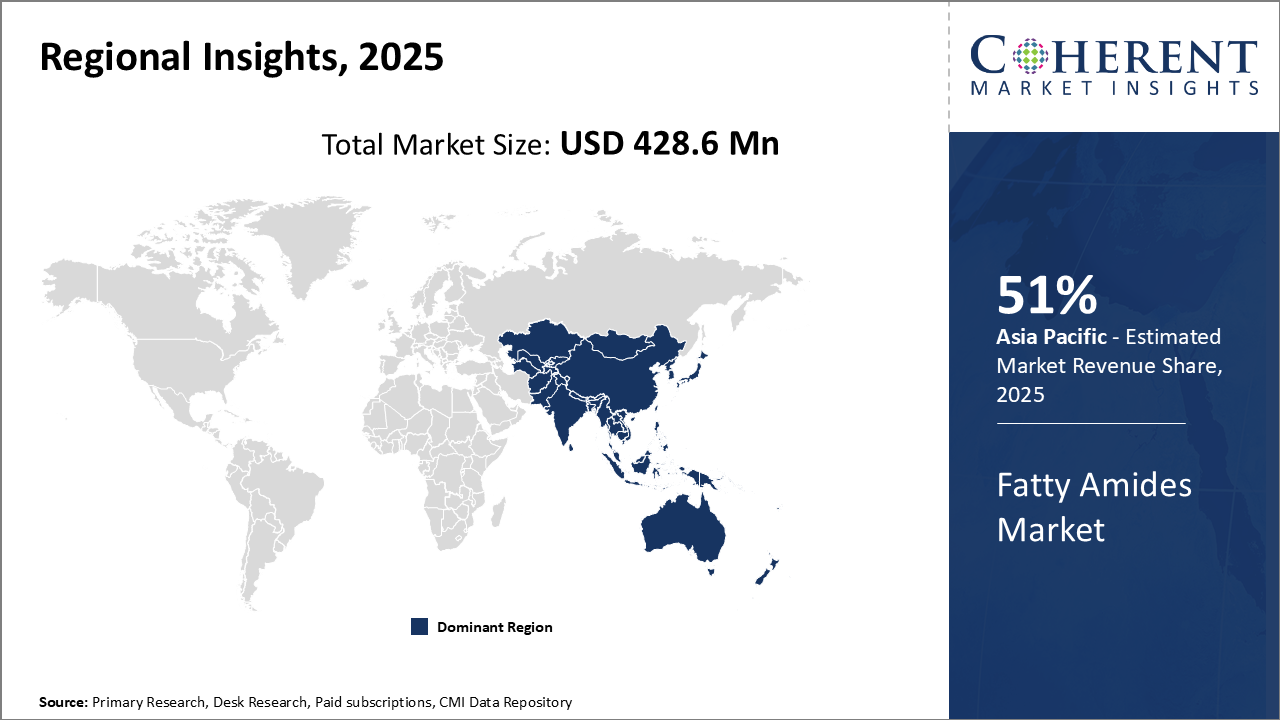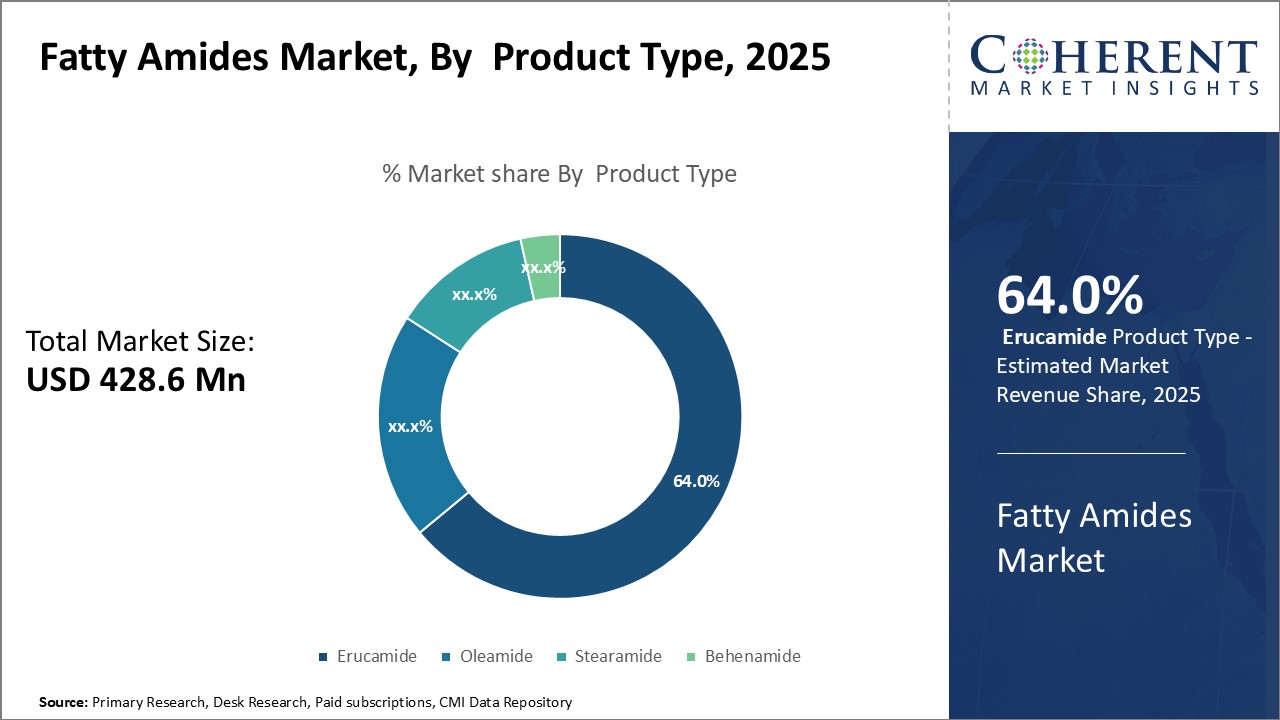The fatty amides Market size is valued at US$ 428.6 Mn in 2025 and is expected to reach US$ 575.5 Mn by 2032, growing at a compound annual growth rate (CAGR) of 4.3% from 2025 to 2032. Fatty amides such as oleamide, behenamide, erucamide, and stearamide are widely used across a variety of industries including plastics processing, rubber, and inks & coatings. Fatty amides are mainly used as slip agents and anti-block agents in the production of polyolefin films & sheets that have applications in the packaging industry. Fatty acids maintain the clarity of polyolefin film and act as an anti-blocking agent. Nearly 70% of fatty amides are used in the film processing industries. Oleamide and stearamide are majorly used by industries such as paper, textiles, rubber, and ink.
Fatty Amides Market Regional Insights:
Figure 1. Fatty Amides Market Share (%), by Region, 2025

To learn more about this report, Download Free Sample
Analyst Viewpoint:
The global fatty amides market is expected to see steady growth over the next five years. The market is driven by the increasing demand from the personal care and lubricants industries. Personal care products containing fatty amides are growing in popularity due to their skin conditioning and hair care properties. The lubricants industry is another major end-use sector for the fatty amides market owing to their benefits as high-temperature lubricants and release agents.
However, the availability of substitutes could limit the growth of the fatty amides market. Natural oils and synthetic alternatives are also used in personal care and industrial applications that provide competition to fatty amides. Stringent environmental regulations around the world pose a restraint as the production process of fatty amides releases harmful emissions.
The Asia Pacific region dominates the global fatty amides market and is likely to witness the fastest growth. The expanding personal care industry in countries like India and China will boost the demand. North America is another major regional market for fatty amides driven by the large lubricants industry in the U.S. and Canada. Opportunities lie in product innovation to replace traditional ingredients and develop bio-based varieties. Successful innovation can help manufacturers gain a competitive edge.
In conclusion, while the fatty amides market will see steady growth based on end-use demand, availability of substitutes and emission norms can limit the expansion to some extent.
Fatty Amides Market Drivers:
Fatty Amides Market Opportunities:
Innovation of fatty amides for niche applications: Innovation of fatty amides for niche applications could unlock great opportunities in the fatty amides market. Fatty amides have traditionally been used primarily as lubricants and release agents in various industries. However, with ongoing research and development, new niche applications of these versatile compounds are being identified.
Many new discoveries relate to the use of fatty amides as slip agents and processing aids. For example, oleamide is being widely studied for its potential as an additive to enhance the flowability and spreadability of silicone sealants, elastomers, and coatings. Oleamide enables better adherence and wetting between silicone formulations and various substrates. According to the United States Environmental Protection Agency, using oleamide and other fatty amides allows significant reduction in silicone raw material usage while maintaining product performance. This could translate to considerable cost savings for manufacturers. For instance, as per the American Chemical Council, the specialty chemicals sector is estimated to grow at over 5% annually between 2022 and 2023.
Growing demand from emerging economies: The growing demand from emerging economies can provide significant opportunities for the fatty amides market in the coming years. Many developing nations in Asia Pacific and South America are witnessing rapid economic and industrial growth which is increasing the disposable incomes as well as consumption abilities of people in these regions. As lifestyle of people improves, there is a growing demand for personal care products, lubricants, pharmaceuticals and other industrial applications where fatty amides are used. For example, countries like India, Indonesia, Vietnam, etc. are experiencing strong growth in the middle class population who are able to spend more on consumer goods. For instance, according to the United Nations, the middle class population in Asia Pacific is expected to rise to over 3.5 billion people by the year 2030 from around 1 billion currently.
Fatty Amides Market Report Coverage
| Report Coverage | Details | ||
|---|---|---|---|
| Base Year: | 2024 | Market Size in 2025: | USD 428.6 Mn |
| Historical Data for: | 2020 To 2024 | Forecast Period: | 2025 To 2032 |
| Forecast Period 2025 to 2032 CAGR: | 4.3% | 2032 Value Projection: | USD 575.5 Mn |
| Geographies covered: |
|
||
| Segments covered: |
|
||
| Companies covered: |
Haihang Industries Co. Ltd., Croda International Plc., PMC Biogenix Inc., Fine Organic Industries Pvt. Ltd., Nippon Fine Chemicals Co., Ltd., Kao Corporation, Italmatch Chemicals S.p.A., Sichuan Tianyu Oleochemical Co., Ltd., and Nippon Kasei Chemical Co., Ltd |
||
| Growth Drivers: |
|
||
| Restraints & Challenges: |
|
||
Uncover macros and micros vetted on 75+ parameters: Get instant access to report
Fatty Amides Market Trends:
Increasing adoption of oleamide and erucamide: The adoption of oleamide and erucamide as slip agents and releasing agents in polymer processing has been growing significantly over the past few years. These fatty amides are increasingly being used in the production of flexible films, blown films, wire and cable coatings, and blow molded containers. Their ability to reduce friction and provide anti-blocking properties makes them favorable over conventional slip and release agents.
Focus on reducing volatility of fatty amides: The fatty amides market has seen a significant shift in focus towards developing less volatile formulations in recent years. Fatty amides are primarily used as slip and anti-block additives in plastic films and food packaging. However, concerns have been growing about the potential health impacts of exposure to these chemicals during product use or disposal. Various toxicology studies have suggested links between higher volatility of certain fatty amides and increased absorption or respiratory issues. This has led to tighter regulation of Volatile Organic Compound (VOC) levels in Europe and other Western markets under REACH. Major brands and retailers are also demanding safer and more sustainable ingredients in the goods they sell.
To comply with these evolving standards and growing consumer awareness, fatty amides producers are investing heavily in research & development to create new low-VOC variants. Layn, a major global producer of fatty amide slip and anti-block additives, launched its Layslip LVO range in 2021 with alkanolamide structures optimized for lower vapor pressures. According to the company’s website, these new grades show equivalent performance to traditional variants but with VOC emissions reduced by over 50% as certified by the ECHA. Major packaging converters like Amcor and Coveris have publicly endorsed adopting these low-VOC solutions in their product portfolios to transition towards greener options.
Fatty Amides Market Restraints:
Availability of substitutes: The fatty amides market has seen a significant shift in recent years towards developing products with lower volatility. Fatty amides are widely used as lubricating agents, greases, release agents, and softening agents. However, the high volatility of traditional fatty amide formulations has posed challenges such as potential safety hazards and inconsistent performance. This has driven strong consumer demand for safer and more stable alternatives.
Counter balance: Enhance the performance and characteristics of fatty amides to make them more appealing. This could involve improving their efficiency in applications, developing more environment-friendly formulations, or increasing their stability and shelf life. Innovation can make your product indispensable or superior to substitutes.
Stringent regulations regarding fatty amides: The fatty amides market has seen a significant shift in recent years towards developing products with lower volatility. Fatty amides are widely used as lubricating agents, greases, release agents, and softening agents. However, the high volatility of traditional fatty amide formulations has posed challenges such as potential safety hazards and inconsistent performance. This has driven strong consumer demand for safer and more stable alternatives.
Many players in the fatty amides industry have responded by investing heavily in research and development to formulate novel variants of fatty amides with markedly reduced volatility. One such innovation is the use of carbon chain lengthening technology during the synthesis process which increases the molecular weight of the resulting amide molecules. Heavier fatty amides have a lower vapor pressure and are therefore less prone to vaporization, especially at higher temperatures.
Counter balance: Ensure that fatty amides not only comply with regulations but exceed them where possible. Use this compliance to differentiate products in the market and communicate it effectively to customers as a value proposition.
Recent Developments:
Acquisitions and partnerships :
Figure 2. Fatty Amides Market Share (%), By Product Type, 2025

To learn more about this report, Download Free Sample
Fatty Amides Market Top Players:
Share
Share
About Author
Vidyesh Swar is a seasoned Consultant with a diverse background in market research and business consulting. With over 6 years of experience, Vidyesh has established a strong reputation for his proficiency in market estimations, supplier landscape analysis, and market share assessments for tailored research solution. Using his deep industry knowledge and analytical skills, he provides valuable insights and strategic recommendations, enabling clients to make informed decisions and navigate complex business landscapes.
Missing comfort of reading report in your local language? Find your preferred language :
Transform your Strategy with Exclusive Trending Reports :
Frequently Asked Questions
Select a License Type
Joining thousands of companies around the world committed to making the Excellent Business Solutions.
View All Our Clients